Eric Solomon was a renowned inventor of games and puzzles and a key figure in the British board game revival of the 1970s. I first met him on the games testing panel of Games & Puzzles magazine in 1973 and we attended many a games event for as long as he was able to get around. He suffered from ill health for more than five years before his death in 2020 at the age of 85. His website was lost, but the following pages are based on material saved from it by Alan Martin. Also, it was last preserved on 26 February 2020 and can be seen at the Internet Archive Wayback Machine.
Conspiracy - the Solomon Gambit
(Restoration Games, USA, 2018)
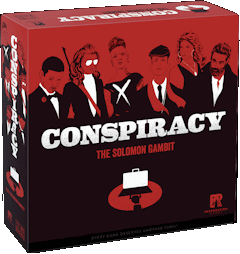 The most recent version of what started out as The Sigma File
in 1972 includes a variation called The Solomon Gambit developed by the publisher. The fact
that the inventor of the game has been made a character in it shows in what high regard Eric was held
by everyone who knew his work. This game of secret bidding for the control of secret agents has been marketed
worldwide under various names and by various manufacturers. That published by Amigo Games
(Germany) was shortlisted for the Spiel Des Jahres in 1991. The Sigma File was first published
in the UK by Seven Towns (1972) and later by Gibsons Games. It also appeared in Germany under the title
Agent (Pelikan Games), in the Netherlands as Dossier X, and in the US by Milton Bradley
under its present title Conspiracy.
The most recent version of what started out as The Sigma File
in 1972 includes a variation called The Solomon Gambit developed by the publisher. The fact
that the inventor of the game has been made a character in it shows in what high regard Eric was held
by everyone who knew his work. This game of secret bidding for the control of secret agents has been marketed
worldwide under various names and by various manufacturers. That published by Amigo Games
(Germany) was shortlisted for the Spiel Des Jahres in 1991. The Sigma File was first published
in the UK by Seven Towns (1972) and later by Gibsons Games. It also appeared in Germany under the title
Agent (Pelikan Games), in the Netherlands as Dossier X, and in the US by Milton Bradley
under its present title Conspiracy.
Corporation
(Nestor, Spain, 2010)
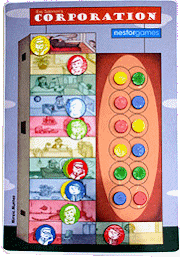 A race game in which players dynamically make the rules governing movement. Originally it was
intended as an abstract game but Nestor found a very appropriate theme involving promotion of favoured
staff to the boardroom of a corporation.
A race game in which players dynamically make the rules governing movement. Originally it was
intended as an abstract game but Nestor found a very appropriate theme involving promotion of favoured
staff to the boardroom of a corporation.
Black Box +
(Franjos 2007)
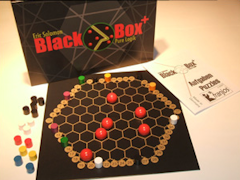 Enhanced version of the original Black Box, regarded by many as a classic game of logic.
Franjos presents the new hexagonal version together with the original game of 1977. The hexagonal
version offers a richer variety of ray effects, and is more demanding. In Black Box, first
published in 1976 by Waddingtons House of Games, a player shoots 'X rays' into a box to determine the positions
of four or five 'atoms' positioned by the opponent. Besides being produced by various manufacturers including
Parker (USA), wrote Eric, 'it has also been very widely pirated as a computer game with no acknowledgements,
and it rankles a bit to see it advertised as Ting's Black Box, and suchlike. I began to collect sites
offering the game but there are so many that I gave up! If you are interested, I suggest doing an internet search'.
Enhanced version of the original Black Box, regarded by many as a classic game of logic.
Franjos presents the new hexagonal version together with the original game of 1977. The hexagonal
version offers a richer variety of ray effects, and is more demanding. In Black Box, first
published in 1976 by Waddingtons House of Games, a player shoots 'X rays' into a box to determine the positions
of four or five 'atoms' positioned by the opponent. Besides being produced by various manufacturers including
Parker (USA), wrote Eric, 'it has also been very widely pirated as a computer game with no acknowledgements,
and it rankles a bit to see it advertised as Ting's Black Box, and suchlike. I began to collect sites
offering the game but there are so many that I gave up! If you are interested, I suggest doing an internet search'.
Billabong
(Franjos (Germany) 1994)
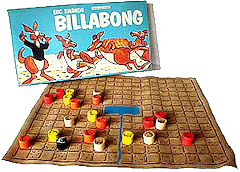 A multi-player race involving teams of kangaroos. It was sublicensed to Amigo who
marketed it under the same name and was shortlisted the Spiel Des Jahres in 1994.
On his turn a player selects one of his kangaroos and executes a series of draughts-style jumps but using
the 'long jump' principle - that is, the kangaroo must land as far beyond its 'pivot' kangaroo (of any
colour) as it starts and there may be no other kangaroos on its path. A 'referee' kangaroo is placed on the
starting square at the start of the turn, and may itself be used as a pivot. Kangaroos may also walk one
square in any direction. They may start the game on any square but must cross the start/finish line twice to
complete the course, after which they are put into the billabong to cool off. Because leading kangaroos are
useful pivots, the game is almost always a close contest. (Eric posted on his webpage a Java implementation
of Billabong under the title Froggo.
A multi-player race involving teams of kangaroos. It was sublicensed to Amigo who
marketed it under the same name and was shortlisted the Spiel Des Jahres in 1994.
On his turn a player selects one of his kangaroos and executes a series of draughts-style jumps but using
the 'long jump' principle - that is, the kangaroo must land as far beyond its 'pivot' kangaroo (of any
colour) as it starts and there may be no other kangaroos on its path. A 'referee' kangaroo is placed on the
starting square at the start of the turn, and may itself be used as a pivot. Kangaroos may also walk one
square in any direction. They may start the game on any square but must cross the start/finish line twice to
complete the course, after which they are put into the billabong to cool off. Because leading kangaroos are
useful pivots, the game is almost always a close contest. (Eric posted on his webpage a Java implementation
of Billabong under the title Froggo.
Alaska
(Ravensburger, 1979)
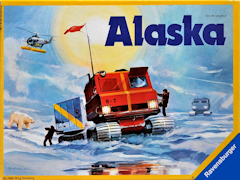 A game involving the collection by snowtrack vehicle of goods from an island surrounded
by sea which progressively freezes in winter, then melts in spring. It was shortlisted for the Spiel Des Jahres
in 1979.
A game involving the collection by snowtrack vehicle of goods from an island surrounded
by sea which progressively freezes in winter, then melts in spring. It was shortlisted for the Spiel Des Jahres
in 1979.
Spellmaker
(Heritage (USA), 1978)
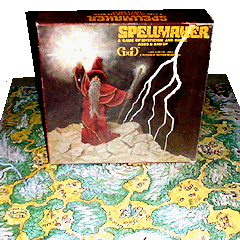 A multi-player game in which wizards cast spells in order to bring a princess to their
own castle. "Having received no royalty statements or payments", wrote Eric on his website, "I was somewhat
concerned. By sheer chance I encountered the chief executive in Dave Rotor's models shop in Victoria. He
assured me that my interests would be 'safeguarded as hitherto they had not been', and offered me £100
cash not to cause trouble. I refused and insisted on proper royalty statements. I should have taken the cash!
Thanks to Stephen Tavener for the picture." (In 2013 I helped Eric redevelop this game, retitled
Spellbinder, and presented it to several publishers at the Nürnberg Toy Fair. One product
development manager was very keen on it but was unable to get it past his games-testing panel.
I rather suspect it was too complicated and may yet try to simplify it - DP.)
A multi-player game in which wizards cast spells in order to bring a princess to their
own castle. "Having received no royalty statements or payments", wrote Eric on his website, "I was somewhat
concerned. By sheer chance I encountered the chief executive in Dave Rotor's models shop in Victoria. He
assured me that my interests would be 'safeguarded as hitherto they had not been', and offered me £100
cash not to cause trouble. I refused and insisted on proper royalty statements. I should have taken the cash!
Thanks to Stephen Tavener for the picture." (In 2013 I helped Eric redevelop this game, retitled
Spellbinder, and presented it to several publishers at the Nürnberg Toy Fair. One product
development manager was very keen on it but was unable to get it past his games-testing panel.
I rather suspect it was too complicated and may yet try to simplify it - DP.)
Balloon Race
(Ravensburger, 1977)
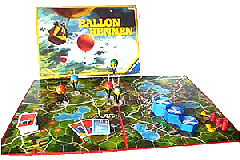 A gas/ballast balloon journey to visit fixed points. Wind direction and strength are
dependent on altitude. Originally the balloons were discs with depressions for holding gas and ballast
counters. Balloons could be stacked at one point and it was easy to see the status of a balloon.
Ravensburger produced a magnificent board, but their three-dimensional balloons required the gas and ballast
to be held off the board, and although they looked good they made play quite difficult.
A gas/ballast balloon journey to visit fixed points. Wind direction and strength are
dependent on altitude. Originally the balloons were discs with depressions for holding gas and ballast
counters. Balloons could be stacked at one point and it was easy to see the status of a balloon.
Ravensburger produced a magnificent board, but their three-dimensional balloons required the gas and ballast
to be held off the board, and although they looked good they made play quite difficult.
Entropy
(Skirrid International, 1977)
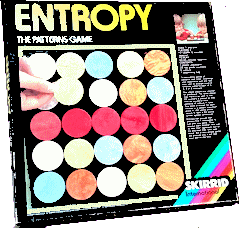 A two-player abstract in which one player acts for the forces of 'chaos'
and the other for the forces of 'order'. The latter attempts to create symmetrical sequences of adjacent
pieces in the rows and the columns. Every distinct symmetric sequence wins as many points as there are pieces
in the sequence. The chaos player attempts to thwart this by, on each turn, drawing (blind) a single piece from
the bag and placing it on the most awkward square possible.
A two-player abstract in which one player acts for the forces of 'chaos'
and the other for the forces of 'order'. The latter attempts to create symmetrical sequences of adjacent
pieces in the rows and the columns. Every distinct symmetric sequence wins as many points as there are pieces
in the sequence. The chaos player attempts to thwart this by, on each turn, drawing (blind) a single piece from
the bag and placing it on the most awkward square possible.
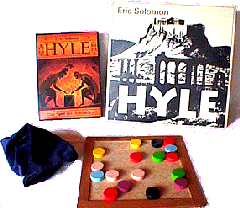 The 'order' player may then slide any one piece
over vacant squares along its row or column. It was also produced by Skirrid under the name Vice-Versa,
and in the USA under the name Vis à Vis (possibly by Selchow and Richter). It is
currently produced in Germany by Franjos under the names Hyle and, in its larger version,
Hyle 7.
It has been included as one of the events at the annual Mind Sports Olympiad
ever since its inception. Some people have suggested that, as pieces are drawn from a bag, chance must play a large
part. That this is certainly not so is confirmed by the fact that the MSO World Championship has been won by
the same person (Demis Hassabis) on four occasions.
The 'order' player may then slide any one piece
over vacant squares along its row or column. It was also produced by Skirrid under the name Vice-Versa,
and in the USA under the name Vis à Vis (possibly by Selchow and Richter). It is
currently produced in Germany by Franjos under the names Hyle and, in its larger version,
Hyle 7.
It has been included as one of the events at the annual Mind Sports Olympiad
ever since its inception. Some people have suggested that, as pieces are drawn from a bag, chance must play a large
part. That this is certainly not so is confirmed by the fact that the MSO World Championship has been won by
the same person (Demis Hassabis) on four occasions.
Thoughtwave
(Intellect Games, 1974)
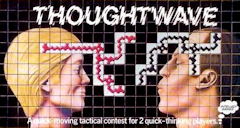 An abstract connection game using square tiles. It was also marketed by Parker
(USA) under the name Ultra.
An abstract connection game using square tiles. It was also marketed by Parker
(USA) under the name Ultra.
Hexagrams
(Games Centre, 1978)
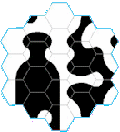 An abstract tiling puzzle involving a mathematically complete group of pieces.
The sample shown here (left) was called 'Weeping Wino'. Eric made
a Java applet and included it in his website. I (DP) have a hard copy of the original game but unfortunately
cannot retrieve the Java applet. However, they have since been re-implemented
in Geogebra by José Montaño at
www.geogebra.org/m/jxmztu3y
and www.geogebra.org/u/jmarmon803.
(Thanks to John Read for these links.)
An abstract tiling puzzle involving a mathematically complete group of pieces.
The sample shown here (left) was called 'Weeping Wino'. Eric made
a Java applet and included it in his website. I (DP) have a hard copy of the original game but unfortunately
cannot retrieve the Java applet. However, they have since been re-implemented
in Geogebra by José Montaño at
www.geogebra.org/m/jxmztu3y
and www.geogebra.org/u/jmarmon803.
(Thanks to John Read for these links.)
BOOKS
Games Programming
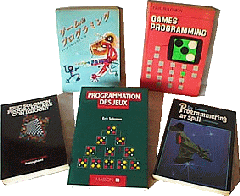 Cambridge University Press 1984. The picture shows covers for some of the
translations. It has to be admitted that, being written before the widespread ownership of PCs, this book is
very out of date with respect to graphics. However many of the data structures and algorithms are still relevant.
Several critics have remarked that it contains a particularly clear explanation of the alpha-beta algorithm.
Cambridge University Press 1984. The picture shows covers for some of the
translations. It has to be admitted that, being written before the widespread ownership of PCs, this book is
very out of date with respect to graphics. However many of the data structures and algorithms are still relevant.
Several critics have remarked that it contains a particularly clear explanation of the alpha-beta algorithm.
Black Box Gamebook
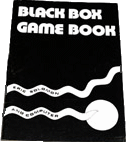 Strategy Games Ltd, 1977. There was an American version of this little book
which presented Black Box puzzles with ray results given at the back in such a way that it was difficult to cheat
in any 'accidental' way.
Strategy Games Ltd, 1977. There was an American version of this little book
which presented Black Box puzzles with ray results given at the back in such a way that it was difficult to cheat
in any 'accidental' way.
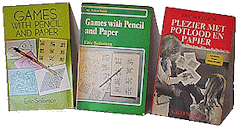
Games with Pencil and Paper Thomas Nelson 1973, Dover 1994. The Dover edition has an informative preface with reference to some game theory results obtained after publication.
